Hendelia
Owen Lonsdale and Steve MarshallIntroduction
Hendelia Czerny is pantropical and south temperate in distribution with 44 described species (Lonsdale & Marshall, 2007). It is the sister genus to the north temperate Clusiodes, with whom it shares a clear north/south division, although the type species (H. beckeri Czerny) is widespread in the Palaearctic.Caloren & Marshall (1998) recently described the behaviour, biology and faunistics of the New World Clusiodes and Hendelia (as the "C. mirabilis" group), and Rohácek (1995) described that of H. beckeri in the Czech and Slovak Republics. A revision of the Neotropical Hendelia is currently under development (Lonsdale & Marshall, in manuscript). Adults of Clusiodes and Hendelia are found predominantly on hardwood, but several Clusiodes have been collected off of softwood trees such as pine, hemlock and fir (Caloren & Marshall, 1998; Rohácek, 1995;Withers, 1985). Species of both genera have been reared from puparia collected in numerous species of rotting deciduous tree trunks including alder, aspen, ash, beech, birch, elm, hornbeam, maple, poplar and tulip trees (Withers, 1985; Greve & Midtgaard, 1986; Rohácek, 1995; Caloren & Marshall, 1998).
A number of Hendelia have strikingly modified heads (presumably associated with male agonistic behaviour), such as the pale excavated head and flattened arista seen in H. beckeri males, the elongate antennae of H. extensicornis Frey, the strongly widened head and corkscrewed vibrissae of several Australian species, and the elongate genal processes of the neotropical H. mirabilis (Frey) and H. kinetrolikros (Caloren & Marshall) (Caloren & Marshall, 1998; Marshall, 2000; McAlpine, 1976). Several of these species have been observed while engaged in male agonistic behavior at lek sites, usually on exposed tree trunks. Tuomikoski (1936) observed the pre-mating behaviour of H. beckeri, where males held their fore legs and "shivered" the fore tarsi when approaching females, using them as feeler-like organs.
In addition to bare patches of wood, we have found that small dung baits attract adults of Clusiodes and Hendelia in the New World.
Characteristics
Species of Hendelia usually range from 3.0-5.3 mm (rarely less than 3.5 mm) in length, but several Old World species are 2.3-2.5 mm and are among the smallest clusiids. Like its sister-genus Clusiodes, Hendelia has reduced anterior and posterior fronto-orbitals, interfrontal bristles, well developed medial genal bristles, swollen spermathecal ducts, a large subapical disc on the ventral receptacle, a longitudinal desclerotization on the female seventh sternite, a crested fin-like phallapodeme, a distiphallus that is rod-like basally with a membranous distal section and an elongate pregonite that is perpendicular to the long axis of the hypandrium (Lonsdale & Marshall, 2007).
Hendelia is entirely defined by male genitalic characters (perianal area longer than wide; surstylus usually small, lobate and perpendicular to the long axis of the epandrium; ejaculatory apodeme widest apically), but it is most easily separated from Clusiodes by retained ancestral states: the arista is variably plumose or laterally compressed (never pubescent); if 3 fronto-orbital bristles are present, the anterior two pairs are usually closely spaced near the anterior margin of frons; the male fore and mid femora have one anterior and one posterior row of ventral ctenidial bristles (never two posterior rows); the scutum never has a white lateral stripe (Lonsdale & Marshall, 2007).

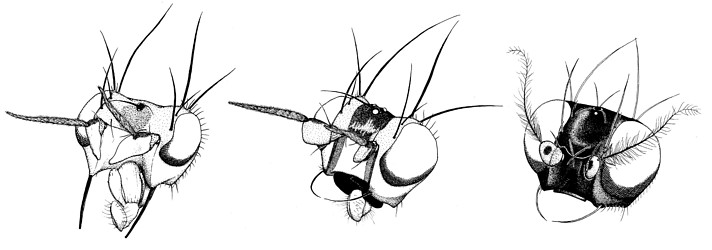
Hendelia head morphology. Hendelia beckeri Czerny, male; H. beckeri, female; Hendelia latifrons (Frey), female. © Owen Lonsdale.

Hendelia beckeri Czerny: male external genitalia, posterior and left lateral (left); male hypandrial complex, left lateral (centre); female internal genitalia (right). © Owen Lonsdale
Phylogenetics
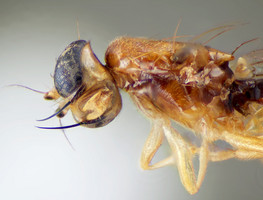
Hendelia sp. © Owen Lonsdale
Hendelia and Clusiodes Coquillett form a natural group, supported by the synapomorphies listed above, and are considered to be monophyletic with Heteromeringia Czerny on the basis of telescoped and darkly pigmented spermathecae (Lonsdale & Marshall, 2006).
Lonsdale & Marshall (2007) drastically redefined the boundaries of Clusiodes and Hendelia, expanding the boundaries of the latter to encompass not only the seven species previously included in Hendelia, but 33 species of Clusiodes (almost all tropical and south temperate species previously placed in that genus), all three species of Prohendelia Frey, and the monotypic Xenoclusia Frey. The much-reduced Clusiodes, most obviously defined by a pubescent arista, three ventral rows of bristles on the femora and white shoulder stripes, is now considered to be almost entirely restricted to the north temperate region.
References
Caloren, D.C. & S.A. Marshall. 1998. A revision of the New World species of Clusiodes Coquillett (Diptera: Clusiidae). Studia Dipterologica 5:261-321.
Greve, L. & F. Midtgaard. 1986. The Clusiidae (Diptera) from the islands Håøya and Ostøya in the Oslofjord and a survey of the family in Norway. Fauna Norvegica Series B 33: 86-92.
Lonsdale, O. & S.A. Marshall. 2006. Revision of the New World Craspedochaeta Czerny. Zootaxa 1291: 1-101.
Lonsdale, O. & S.A. Marshall. 2007. Redefinition of the genera Clusiodes and Hendelia (Diptera: Clusiidae: Clusiodinae), with a review of Clusiodes. Studia Dipterologica 14: 117-159.
Marshall, S.A. 2000. Agonistic behaviour and generic synonymy in Australian Clusiidae (Diptera). Studia Dipterologica 7: 3-9.
McAlpine, D.K. 1976. Spiral vibrissae in some clusiid flies (Diptera: Schizophora). Australian Entomological Magazine 3(4): 75- 78.
Rohácek, J. 1995. Clusiidae (Diptera) of the Czech and Slovak Republics: Faunistics and notes on biology and behaviour. Cas. Slez. Muz. Opava (A) 44: 123-140.
Tuomikoski, R. 1936. Bemerkungen über die Clusiiden (Dipt.) Finnlands. Annals Entomologici fennici 2(4): 182-186.
Withers, P. 1985. Notes on some British Clusiidae and reduction of Clusiodes facialis (Coll.) to synonymy. Proceedings of the Transactions of the British Entomological Natural History Society 18: 63-64.
Title Illustrations

| Scientific Name | Hendelia gladiator (McAlpine) |
|---|---|
| Location | Australia |
| Specimen Condition | Live Specimen |
| Sex | Male |
| Copyright |
© 2004 Steve Marshall

|
| Scientific Name | Hendelia kinetrolikros (C&M) |
|---|---|
| Location | Neotropics |
| Specimen Condition | Dead Specimen |
| Sex | Male |
| Life Cycle Stage | Adult |
| Image Use |
 This media file is licensed under the Creative Commons Attribution-NonCommercial License - Version 3.0. This media file is licensed under the Creative Commons Attribution-NonCommercial License - Version 3.0.
|
| Copyright |
© Owen Lonsdale

|
| Scientific Name | Hendelia mirabilis (Frey) |
|---|---|
| Location | Neotropics |
| Specimen Condition | Dead Specimen |
| Sex | Female |
| Life Cycle Stage | Adult |
| Image Use |
 This media file is licensed under the Creative Commons Attribution-NonCommercial License - Version 3.0. This media file is licensed under the Creative Commons Attribution-NonCommercial License - Version 3.0.
|
| Copyright |
© Owen Lonsdale

|
| Scientific Name | Hendelia mirabilis |
|---|---|
| Location | Costa Rica. Monteverde |
| Specimen Condition | Live Specimen |
| Identified By | O. Lonsdale |
| Sex | Female |
| Life Cycle Stage | Adult |
| Copyright |
© Steve Marshall

|
About This Page
Owen Lonsdale

Canadian National Collection of Insects, Arachnids & Nematodes
Steve Marshall

University of Guelph, Canada
Correspondence regarding this page should be directed to Owen Lonsdale at
Neoxabea@hotmail.com
and Steve Marshall at
samarsha@uoguelph.ca
Page copyright © 2011 Owen Lonsdale and Steve Marshall
 Page: Tree of Life
Hendelia.
Authored by
Owen Lonsdale and Steve Marshall.
The TEXT of this page is licensed under the
Creative Commons Attribution-NonCommercial License - Version 3.0. Note that images and other media
featured on this page are each governed by their own license, and they may or may not be available
for reuse. Click on an image or a media link to access the media data window, which provides the
relevant licensing information. For the general terms and conditions of ToL material reuse and
redistribution, please see the Tree of Life Copyright
Policies.
Page: Tree of Life
Hendelia.
Authored by
Owen Lonsdale and Steve Marshall.
The TEXT of this page is licensed under the
Creative Commons Attribution-NonCommercial License - Version 3.0. Note that images and other media
featured on this page are each governed by their own license, and they may or may not be available
for reuse. Click on an image or a media link to access the media data window, which provides the
relevant licensing information. For the general terms and conditions of ToL material reuse and
redistribution, please see the Tree of Life Copyright
Policies.
- First online 25 August 2005
- Content changed 24 November 2009
Citing this page:
Lonsdale, Owen and Steve Marshall. 2009. Hendelia. Version 24 November 2009 (under construction). http://tolweb.org/Hendelia/27685/2009.11.24 in The Tree of Life Web Project, http://tolweb.org/




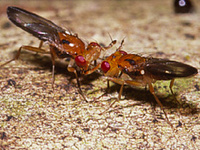
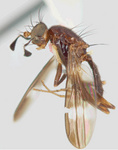
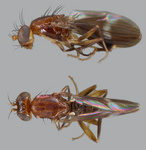
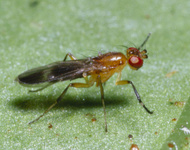
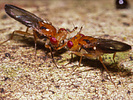





 Go to quick links
Go to quick search
Go to navigation for this section of the ToL site
Go to detailed links for the ToL site
Go to quick links
Go to quick search
Go to navigation for this section of the ToL site
Go to detailed links for the ToL site